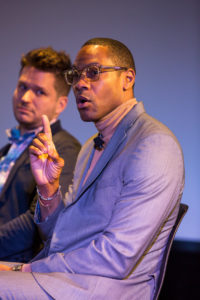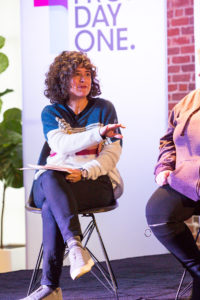How Can We Get Bias Out of Our Systems?


As diversity-and-inclusion programs have become standard across most corporations, they’ve made strides toward better equity in pay, organizational culture, and advancement opportunities. But what remains stubborn is bias, not only individual but systemic. How do we root it out?
That’s the question panelists tackled at From Day One’s Los Angeles conference during a conversation moderated by Los Angeles Times staff writer Carolina Miranda, who is also co-chair of the paper’s labor union.
“So much of the conversation today is about bias training,” said Liji Thomas, head of diversity and inclusion at Southern California Edison. “What 50-plus years of diversity-and-inclusion work has taught us is that if your efforts are limited to training, you’re really missing the boat on this stuff. Mitigating bias in our intra systems, understanding the barriers faced by underrepresented talent–women, people of color–is absolutely critical to long-term diversity-and-inclusion sustainability.”
At Southern California Edison, she said, the company has been “looking at the barriers. It’s understanding barriers across the age and life-cycle intersectionality and taking a data-driven approach. If you’re just looking at race and gender, it can really mask barriers that folks have been experiencing. So getting really smart about diversity is something that we are absolutely looking at.”
Kristena Hatcher, HR executive for inclusion and diversity at CAA, said the company has even employed a writing-platform app which screens job ads and emails to “rid language that basically could eliminate or keep certain groups of individuals from applying … there are words that traditionally don’t resonate with women or underrepresented communities.”

“It’s a very handy system that can help you be more thoughtful about unintentionally excluding people when you’re trying to bring these diverse individuals into your company,” she said.
She acknowledged that “training is not the be-all-and-end-all,” however, particularly in the fast-paced and competitive industry of talent representation.
“Something that I’m passionate about is education when it comes to an employee population that literally is focused on getting their clients jobs,” she said. “We focus so much externally; how do we educate employees internally to make sure that there is buy-in and that their efforts are sustainable?”
Education and training at CAA “empowers them to understand it’s not just recruiting,” she said. “At the end of the day, our agents and executives are the hiring managers, so we want to make sure they’re being as thoughtful as possible as they’re making their hiring decision. We know we all have bias, but how do we attack that and understand? How do we flush that out of our systems when we’re going through interviews and someone many not look like us?”
At Control Risks, a consulting firm where Alex Seiler is partner and head of human resources for the Americas, the hiring process has become focused on rooting out innate bias, he said. Many of the company’s hires come from male-dominated professions including global security and intelligence.
“We are taking our leaders on a journey of self-discovery around, really, what their biases are–really being able to see them–but also being able to create talent processes that are equitable and fair and transparent,” he said.
When joining Control Risks, partners must go through a process administered by the PAC, or partner appointment committee. The panel aims to ensure gender diversity, departmental diversity and other diversity-and-inclusion goals in a process that is “global in its approach.”
“If somebody on the PAC is not happy with a particular candidate, they can very well block” the appointment, he said, noting that it “really does take out that sense of hierarchy.”
“Our clients are international and diverse by nature,” he said, adding: “We’ve operated in a lot of countries where English is not the first language, so when we go through this process, we don’t use the word ‘cultural fit,’ we focus on language around behaviors and values to really kind of look at something that works across the globe.”

He added: “You have to be thoughtful. First of all, we’re picking from a market, first of all, which is largely male-dominated. And it’s very much niche in nature. So we can really try to go out of our way to make sure we’re looking at atypical, non-traditional types of channels to bring in people.”
“The PAC, in particular … I think has really kept us honest.”
But sometimes companies–and employees–need additional, slightly selfish motivations to keep them honest, said Marion Brooks, vice president and U.S. head of diversity and inclusion at Novartis, the pharmaceutical giant.
“I think the whole diversity thing, the inclusion conversation, has to be shifted to ‘What’s in it for me?’ for the individual to really buy into it,” he said. “Research shows that there are clear benefits that organizations receive from having more diverse teams. No. 1: Higher revenues. No. 2: They’re more innovative. And No. 3: More responsive to customer needs. So I don’t care if it’s a Little League team or a major corporation, no organization does not want those three things,” Brooks said.
“I start all of my conversations saying: ‘If we believe the research, and these are the three benefits, now how do we execute them? How do we make sure we have more diverse teams?’”
Brooks cited research published by Harvard Business Review showing that, if only one person of color or woman is in a candidate pool, they have statistically zero chance of getting the job. Adding just one additional woman or person of color raises their chances to 50%.
“By simply diversifying the candidate pools–and not just [people who] submit resumes, but get interviews–and holding a standard to that, you significantly increase the opportunity to diversify your work teams.”
Now at Novartis, Brooks said, new hiring guidelines mandate that “you have to have at least one woman and one woman of color in the final candidate pool, or you cannot move forward with the role.”
Southern California Edison’s Thomas pointed out another “gender-diversity fact: Men tend to be promoted on potential and women tend to be promoted on past performance.”
“There are all these subtle ways in which bias creeps into your systems, and if you’re not smart about mitigating bias in your systems, again I’ll go back to the training: [It] does no good if you’re not introducing smart inclusion in places where it really matters for people.”
Ilit Ratz is the founder and CEO of Joonko, which is focused on placing women, veterans, and underrepresented communities in companies around the world by matching up relevant candidates to an employer's open positions and encouraging them to apply, thus increasing qualified, diverse talent's exposure to a company's open positions.

Joonko, she said, was encouraging companies to look at potential as well as experience, noting that women often underestimate themselves when assessing their suitability for a job.
“Women apply if they’re 100% qualified for a job,’ she said. ‘Men apply if they’re 60% qualified. We’ve got to try to encourage those underrepresented candidates to apply, even if they’re not a 100% fit.”
The goal, she says, is “to encourage people to apply for jobs that are 80% or 70%” a fit.
Another issue, she said, is visibility.
“I think a lot of employees … have zero to limited visibility” across a company, she said, adding: “We encourage companies … to give opportunities to employees across the company to do small activities that they relate to.”
“I mean, something for women’s month or African-American month … anything that you budget and sponsor as a company for them to feel that they belong and are just included.”
Sheila Flynn is a New York-based journalist who has written for DailyMail.com, the Irish Daily Mail, and the Associated Press. She is a graduate of the University of Notre Dame
The From Day One Newsletter is a monthly roundup of articles, features, and editorials on innovative ways for companies to forge stronger relationships with their employees, customers, and communities.